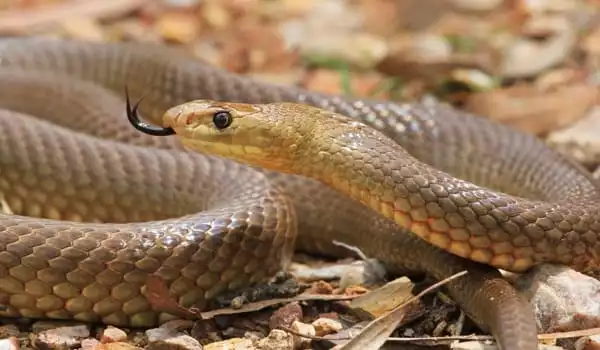Deadly snakes are among Australia’s most iconic animals, but a new study led by the Australian National University (ANU) has helped explain how they descended from creatures that migrated from Asia 30 million years ago. According to Dr. Paul Oliver, the lead researcher, approximately 85% of Australia’s more than 1,000 snake and lizard species descended from creatures that floated across waters from Asia to Australia. The findings help to explain how Australia has become home to approximately 11% of the world’s 6,300 reptile species – the highest proportion of any country on the planet.
A new study led by the University of Adelaide has discovered the first tangible evidence that the ancestors of some of Australia’s most venomous snakes arrived by sea rather than land, which is how most other Australian reptiles disperse. The researchers compared the genomes of two Australian elapids (front fanged snakes), a tiger and a brown snake, to marine and semi-marine elapid sea snakes and Asian elapids in a paper published in Genes.
They deduced that the ancestor of all Australian elapids had accumulated self-replicating and self-mobilizing genes (jumping genes) that were not found in their land relatives and came from a different source entirely.
During our research, we discovered a number of genes that were present in the ancestor of all Australian elapids but could not be traced back to a snake ancestor; instead, they could be traced back to similar transposable gene sequences found in marine life, such as fish, sea squirts, sea urchins, bivalves, and turtles.
Professor David Adelson
“While we know all marine and semi-marine sea snakes descended from a common Australian land-based ancestor, the origin of Australian elapids has been debated for some time,” says corresponding author Professor David Adelson of the University of Adelaide’s School of Biological Sciences.
“During our research, we discovered a number of genes that were present in the ancestor of all Australian elapids but could not be traced back to a snake ancestor; instead, they could be traced back to similar transposable gene sequences found in marine life, such as fish, sea squirts, sea urchins, bivalves, and turtles.”
“This suggests that the new genetic material was transferred into the snakes by the marine environment, lending credence to the theory that the first Australian elapids swam to our shores. They must have acquired the new genetic material previously during an ancestral period when they were adapted to sea life.”

“Around 30 million years ago, it appears that the world changed, and subsequently there was an influx of lizards and snakes into Australia,” said Dr. Oliver from the ANU Research School of Biology. “We think this is linked to how Australia’s rapid movement north, by continental movement standards, has changed ocean currents and global climates.”
The study was carried out using animal tree-of-life data, empirical evidence, and simulations. Myths and urban legends have conspired against many Australian animals, resulting in a negative image of some species. However, ask any local and they will tell you that Australia is safe and that most of our wildlife is more afraid of you than you are of it.
The researchers discovered 14 distinct transfer events of new genetic material from other marine organisms, with eight genes found only in the genomes of marine and semi-marine sea snakes. The acquired genes accounted for as much as 8-12 percent of the total genome sequence in the case of the semi-marine snake genome.
“This meant we could unambiguously determine that the major genetic differences between land and marine/semi-marine snakes were a result of migration into a marine environment,” Professor Adelson explained.
“This is the first time jumping genes have been used to confirm the evolutionary history of any animal species, and the findings conclusively demonstrate that the common ancestor of all Australian elapids adapted to a marine environment. It may also have facilitated sea snakes’ subsequent land-to-marine transition.”
Reptile origins contrast with those of other well-known Australian animal groups, such as marsupials and birds, which include many more species descended from ancestors who lived on Gondwana, a supercontinent that included Australia, Antarctica, South America, Africa, and Madagascar.















